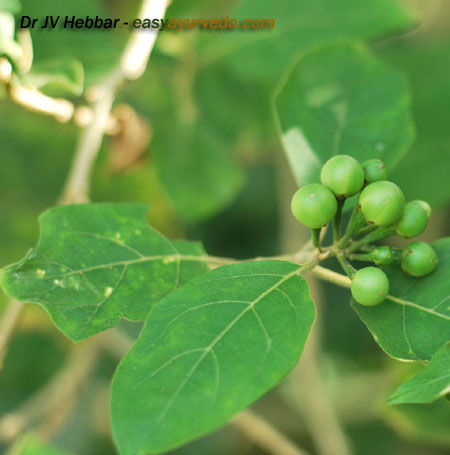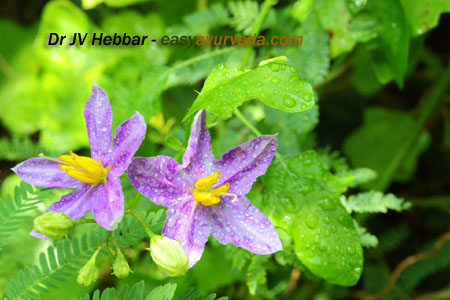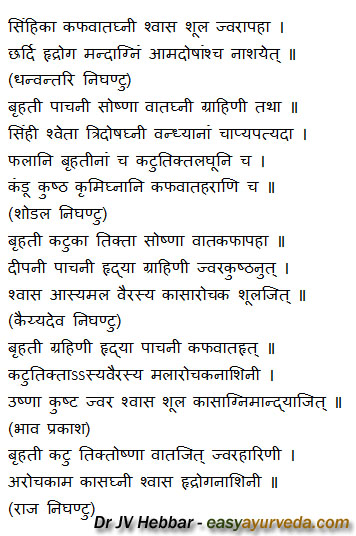Brihati Solanum indicum Qualities, Benefits, Dose, Side Effect
Brihati – Solanum indicum is one among Dashamoola – a group of 10 roots, having potent anti-inflammatory activity. Apart from its root, its fruit is also used in treatment. It is widely used in treating respiratory disorders.


Botanical Name: Solanum Indicum Linn. S . Ferox L. NoN Ambig
Family- SOLANACEAE (Kantakari Kula)
Table of Contents
Vernacular Name
Hindi Name – Badi Kateri, Vanabhanta
Telugu Name – Pedda Mulaka, Tella Mulaka
Bengali Name – Rambegun, Vyakud
Tamil Name – Anachundai, Papparamalli,
Marathi Name- Dorali
Gujrati Name- Ubhi ringani
Farsi name – Katai Kalaam
English name – Poison Berry, Indian Nightshade, African Eggplant, Bush Tomato,
Sanskrit Synonyms
Bruhati – Brihat means big in size. Often, Brihati and Kantakari are considered together, in the name of Brihati Dwaya. Among these Brihati is larger and Kantakari is smaller. Mahati is also the name given to this, based on the same principle.
Kshudrabhantaki – Bhantaki means EggPlant. This plant’s structure is similar to Eggplant in structure. Another synonym – Vartaki is also given based on the same principle.
Simha – Simha means lion. Regular use of Bruhati makes the throat as strong as a lion’s. Like Kantakari, it is also used in treating throat, and respiratory tract diseases.
Duspradharshini, Hinguli
Mahati – Useful in many diseases hence respected by all
Pita phala – Fruits of Brihati is yellow
Kantaki – Plant bears thorns
Classical Categorization
Charaka Samhita –
Kanthya – group of herbs used in throat disorders
Hikkanigrahana – group of herbs used in treating hiccups
Shothahara – anti inflammatory group of herbs
Angamarda Prashamana – Pain relieving group of herbs
Sushruta- Bruhatyadi, Laghu Pancamula
Vagbhata- Bruhatyadi
Bha. pr – Guduchyadi varga
Varieties
RA Ni
Bruhati
Sarpatanu
Shveta Brihati
Different species
Solanum indicum
Solanum torvum
Kaiyadeva enumerated 11 varieties of Brihati – Simhi, Brhati, Kantakari, Nidigdhika, Valli Brhati, Vrtra Brhati, sveta Brhati, Alambu Phala Brhati, Amla Brhati, Jala brhati, and Sthula Brhati.
Distribution
Found in the tropical parts of India.
Morphology
Shrub with herbaceous, branched, green, prickly stem
Leaves – Simple, opposite, exstipulate
Inflorescence – Extra axillary corymbose cyme
Flower- bisexual
Fruits – Berry, green, globose, pulpy
Seeds – Circular, smooth
Major Chemical Constituents
Solanine, Carotene, Carpesterol, Solanocarpone, Diosogenin, B- Sitosterol, Lanosterol, Solasonine, Solamargine, Solasodine, vit. C etc
(Reference: Illustrated Dravyaguna Vijnana, Vol. II, by Dr JLN Shastry)
Medicinal qualities
Solanum indicum – medicinal qualities
Rasa (taste) – Katu (pungent), Tikta (bitter)
Guna (qualities) – Laghu (lightness), Rooksha (dryness)
Veerya – Ushna – hot potency
Vipaka – Katu – undergoes pungent taste conversion after digestion
Effect on Tridosha
Effect on Tridosha – Balances Kapha and Vata.
Actions
Kasahara, Hridya, Pachana, Ruchikara, Kushtaghna,S wasahara
Pharmacological Action
Carminative, Aphrodisiac, Cardiac tonic, Analgesic, Expectorant
Part used, Dosage
Part used- root , fruit
Dosage:
Powder -1- 2 grams, in divided dose per day,
Water decoction (Kashaya) – 50 – 100 ml, in divided dose per day, based on doctor’s advice.
Sanskrit verse

Medicinal uses
Brihati – Solanum indicum – medicinal uses:
Root –
Shwasaapaha – useful in asthma, chronic respiratory disorders
Shoolaapaha – useful in relieving abdominal colic pain
Jwaraapaha – relieves fever
Chardi – relieves vomiting
Hrudroga – useful in cardiac disorders
Mandagni – useful to improve digestion strength
Amadosha – Useful to relieve Ama – a product of impaired digestion and metabolism
Paachani – digestive,
Graahini – has absorbent property. Useful in diarrhea, IBS and malabsorption syndrome
Vandhyaanaam apathyadaa – Used in treating female infertility
Deepani – carminative
Hrudya – acts as cardiac tonic
Aasya Mala Vairasya – relieves tongue coating. relieves bad breath
Arochaka – useful in anorexia
Kushtajit – useful in skin diseases
Agnimandyajit – useful in low digestion strength
Vatajit – Useful in Vata disorders (neurological)
Shukra rechaka – helps in semen ejaculation problems.
It is useful in blood detoxification,
It has diuretic action
Its seed paste is applied over penis to improve erection
Its juice extract is used for external application in alopecia treatment.
It is used in treating secondary amenorrhea, difficulty in childbirth and diseases related to post delivery (post partum) period.
Bruhati Fruit –
Katu, Tikta – pungent, bitter in taste
Laghu – lightness
Kandughna – useful to relieve itching, pruritus
Kushtaghna – useful in skin diseases
Krumighna – relieves worm infestation
Kapha Vata Hara – Balances Vata and Kapha
Side effects
None.
For pregnant mothers and children, it is best to consult a doctor before using this herb.
Interaction with medicines, supplements
Can this be used while taking Homeopathic medicine?
Yes. This product does not react with homeopathic medicine.
Can this medicine be continued while taking supplements like multivitamin tablets, Omega 3 fatty acids etc?
Yes. Generally, this product goes well with most of the dietary supplements. However, if you are taking more than one product per day, please consult your doctor for an opinion.
With western medicines
Seek your doctor’s advice if you are taking this product along with other western (allopathic / modern) medicines. Some Ayurvedic herbs can interact with modern medicine.
If both Ayurvedic and allopathic medicines are advised together, then it is best to take Allopathic medicine first, wait for 30 minutes and then take the Ayurvedic medicine.
Scientific research
Solanum indicum – scientific research:
Evaluation of laxative and cardiotonic activity
Anti-dermatophytic activity
Anti bacterial potentials
Experimental evaluation of anti hypertensive activity on distichum extract of Solanum indicum
In vitro anti oxidant and anthelmintic activity
Ayurvedic medicines
Famous Ayurvedic medicine with Brihati as ingredient-
Nalikerasavam – used in premature ejaculation
Ajamamsa Rasayanam – used in neurological disorders
Manasamitra Vatakam – used in psychological disorders like stress, insomnia, depression
Sthanika karma (Systemic Acton)
Externally – Anti microbial, relieve pain and swelling. Fruit powder of Brihati along with Turmeric and Tree Turmeric can be used for fumigation in the vaginal area in case of itching. External application of its seed paste is indicated in impotency conditions. In Alopecia aerate its juice can be applied on scalp
Internally
Digestive system – Carminative, Anthelmintic, digestive and absorbent. Indicated in loss of appetite, worm infestation, abdominal cramp, Anorexia etc. Fruit juice along with cow ghee and Honey is beneficial in vomiting.
Circulatory System – Seed powder can be administered as Nasya to regain consciousness. Stimulate heart.
Respiratory System – Pacify kapha dosha. Indicated in kasa (Cough), hiccough and in breathing difficulties, rhinitis etc.
Excretory system – it increases urine production, Indicated in renal stone, Dysuria etc.
Reproductive System – Seed is Aphrodisiac and causes uterine contraction. White flowered variety has garbhasthapana property ( prevents abortion). Indicated in Amenorrhea and in Dysmenorrhea and in impotency.
Skin – Induce in skin disorders (Kushta)
Indicated in fever ( jvara)
Collection and preservation of Solanum indicum
Best collection time is April, after the plant is 9 – 10 month old.









12 comments on “Brihati Solanum indicum Qualities, Benefits, Dose, Side Effect”
Vishnu Prasad
Very useful information
Dr J V Hebbar MD(Ayu)
Thank you!
B.Ganesh Rao
Good info about solanum torvum. Please advise as how best can we use this plant when grown in abundance at home .
TINKLE
sell it
malkeet gil
how long term it can be used continue?
Dr J V Hebbar MD(Ayu)
It can be administered for 3 – 4 months, based on need.
Shiva Prasad Mohanty
English name is not mentioned.
Dr J V Hebbar MD(Ayu)
Thanks for pointing out. – Poison Berry, Indian Nightshade, African Eggplant, Bush Tomato,
Dileep K Nair
No need of any kashayam and all .. You can have it row. Its works very well. Just wash it before using it. That’s all. This is the best medicine. In Arunachal Pradesh people use it as in daily basis . Arunachal blessed with ayurveda medicines . There is no hospital here. People are healthy.
Dr J V Hebbar MD(Ayu)
Nice to know. Thanks.
Arun Kumar
How consume this plants as row? The fruits and leaves and quantity,
Dr J V Hebbar MD(Ayu)
Powder – 2 grams once or two times a day after food.
Water decoction – 1 tablespoon of powder mixed with a cup of water, boil for 1 minute, filter and consume 15-20 ml, once or twice a day.